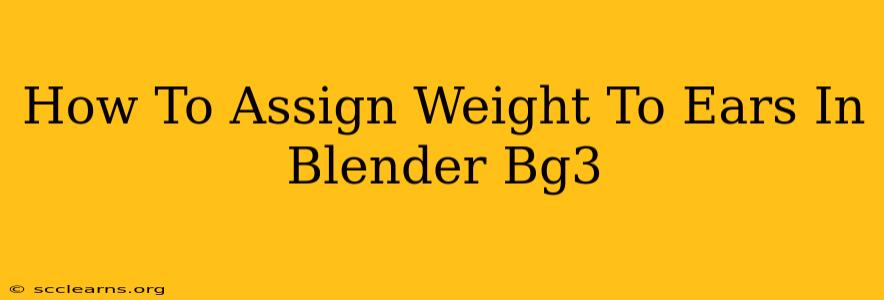Creating truly unique and believable characters in Baldur's Gate 3 often requires meticulous attention to detail, and that includes properly weighting your character's ears. If your ears are clipping through the head, moving weirdly, or generally behaving unexpectedly in-game, it's likely due to incorrect weight painting in Blender. This guide will walk you through the process of assigning weights to ears in Blender to achieve smooth and natural animation.
Understanding Weight Painting in Blender
Before we dive into the specifics of ear weighting, let's briefly cover the concept of weight painting itself. Weight painting is a crucial step in character rigging and animation. It defines how much influence each bone in the rig has on a specific vertex (point) of the mesh. This allows for realistic deformation and movement of the character's body parts, including—you guessed it—the ears.
Key Terms to Know:
- Vertex: A single point on the 3D model's surface.
- Bone: Part of the armature (skeleton) that controls the movement of the mesh.
- Weight: A value between 0 and 1 that determines the influence a bone has on a vertex. 0 means no influence, and 1 means complete influence.
- Weight Painting Mode: The mode in Blender that allows you to assign weights to vertices using a brush.
Step-by-Step Guide to Weight Painting Ears in Blender for BG3
This guide assumes you already have a rigged character model in Blender, with bones assigned to the head and ears. If not, you'll need to complete the rigging process first.
1. Enter Weight Paint Mode:
Select your character model in Blender's viewport. Then, go to the "Edit Mode" and switch to "Weight Paint" mode. You'll find this in the Mode selection menu at the bottom of the viewport.
2. Select the Appropriate Bone:
In the "Armature" tab of the Properties panel (usually on the right-hand side), choose the bone that controls the movement of your character's ear(s). Typically, this will be a bone named something similar to "ear.L" or "ear.R" (for left and right ears respectively). Ensure the bone is selected in the Armature, not the Mesh.
3. Adjust your Brush Settings:
Before you begin painting, take a moment to configure your brush settings. You'll want a brush size that's appropriate for the size of the ear. Start with a smaller brush and increase its size as needed. You can also adjust the brush strength to control the intensity of your paint strokes.
4. Paint the Weights:
Now, using your brush, carefully paint the weights onto the vertices of your ear mesh. Start by painting a strong weight (close to 1) around the entire ear, ensuring that the ear moves correctly in relation to the ear bone. If parts of the ear don't move as expected, you may need to increase or decrease the weight in specific areas.
5. Address Clipping Issues:
If you notice any clipping issues (the ear intersecting the head), you will need to adjust the weight carefully. In areas where the ear is clipping, reduce the weight on vertices close to the head. This will allow the head bone to influence the mesh's movement near the area of contact.
6. Smooth the Weights:
After painting, you might find some harsh weight transitions. Use Blender's smoothing tools (usually found in the weight painting options) to create a smoother transition between areas with different weights.
7. Test Your Rig:
Go back to "Object Mode," and pose your character's head and ears. Observe the ear movement to ensure it's natural and free from any glitches.
8. Repeat for the Other Ear:
Repeat steps 2-7 for your other ear.
Troubleshooting Tips
- Clean Topology: Ensuring you have clean topology (well-organized mesh structure) will greatly improve your weight painting results.
- Multiple Bones: If your ear has complex movement, you might need to use multiple bones to control different parts of the ear.
- Symmetry: Consider using Blender's symmetry tools to help paint weights evenly on both ears.
By following these steps, you can effectively assign weights to your character's ears in Blender and prepare your customized BG3 character for a more immersive and glitch-free gaming experience. Remember patience and practice are key to mastering weight painting!

